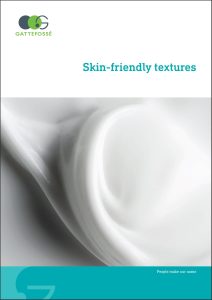Skin-friendly textures – by Gattefossé
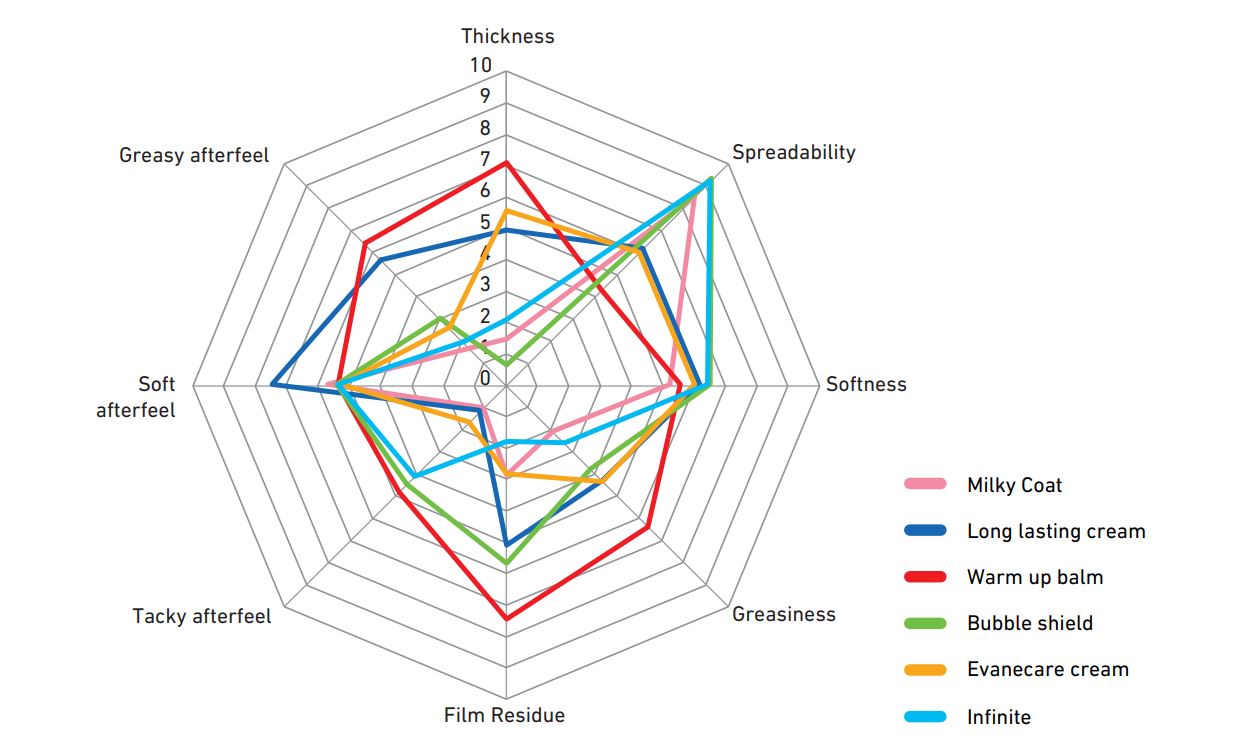
Caring for patients
Patient preferences and needs as well as therapeutic indication should be considered at early stage of development of topical or transdermal formulations.

To increase adherence to skin treatments, it is important to consider patient’s needs, when designing the dosage form:
On which part of the body will the product be applied? Is it to be applied on large areas or on a very localized spot? Is it a hair-bearing area? Is the skin sensitive or dry? Are there lesions on the skin? What is the skin pH? Is it to be used on-the-go? Is it to be applied just before getting dressed?
The therapeutics also guides the choice of the dosage form:
For which indication is it used? Is it a chronic or an acute disease? How many times should the product be applied daily? Should the dose be delivered with a metered device? How long the treatment should last? What is the therapeutic dose?
Patient-centered mapping of topical dosage forms
(click each graphic to enlarge)
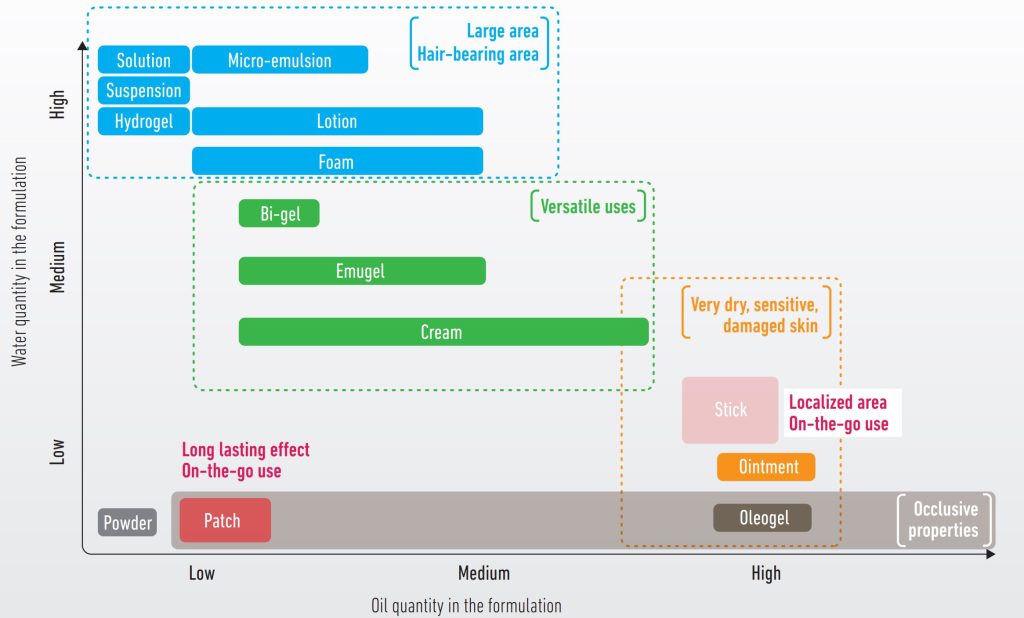
At Gattefossé, we care for patient considerations and expectations for sustainable, natural and safe excipients.
Our excipients are mainly derived from vegetable, renewable origin. We are committed to integrating the use of certified sustainable palm oil. Our range of functional excipients includes PEG-free emulsifiers, thickeners, oily vehicles and solubilizers.
Gattefossé solutions for each dosage form
Emulsion-based semi-solid dosage forms
Selecting the most appropriate emulsifier

Our emulsifiers are all-in-one self-emulsifying bases, enabling the preparation of homogenous emulsions with pleasant textures. Guidance is provided to help selecting the most appropriate emulsifier depending on the active ingredient properties, the final dosage form and the quantity of oil our emulsifiers can disperse.

Adding a stabilizing agent helps guaranteeing the emulsion stability over its shelf-life
An emulsion consists of an oily phase, an aqueous phase and an emulsifier and is, by nature, an unstable thermodynamic system. To ensure shelf-life stability of final dosage forms, it might be necessary to stabilize the system by acting on one or more of its components.
The use of a gelling agent in the aqueous phase increases its viscosity dramatically. The polymer chains stiffen the aqueous phase, preventing oil droplet movement.
Co-emulsifiers reinforce the action of the emulsifier at the interface between the aqueous and oily phases.
Choose among our win-win combinations:
- Tefose® 63 + Labrafil® M 1944 CS (2:1)
- Tefose® 1500 + Labrafil® M 2130 CS (2:1)
- Gelot™ 64 + Emulcire™ 61 WL 2659 (1:1)
- Plurol® Diisostearique + Plurol® Oleique CC 497
Increasing the viscosity of the oily phase reduces the risk of oil droplet coalescence. This can be achieved with solid thickeners that recrystallize in the oil droplet or liquid oil-stabilizing agent.
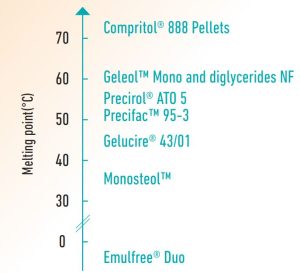

Gel-based semi-solid dosage forms

Depending on the active pharmaceutical ingredient properties, the choice towards conventional oleogels or hydrogels can be made. Alternatively, innovative bi-gels can be prepared using Emulfree® Duo.
- Hydrogels are obtained with carbomers, hydroxyethylcelluloses or hydroxypropylcelluloses. Clear gels are obtained with Transcutol® P, whatever its concentration and the gelling agent used.
- Bi-gels consist of an intimate mixture of an aqueous gel and an oily gel. Using Emulfree® Duo as oil-stabilizing agent,
bi-gels are easily obtained at room temperature. - Oleogels are obtained by adding thickeners to the oily vehicles.
Liquid dosage forms
Microemulsions are thermodynamically stable systems, formed spontaneously by gentle mixing of their components: oily vehicle, surfactant/co-surfactant and water. Microemulsions can be used as such, or for the preparation of innovative pharmaceutical foams using propellant-free devices.
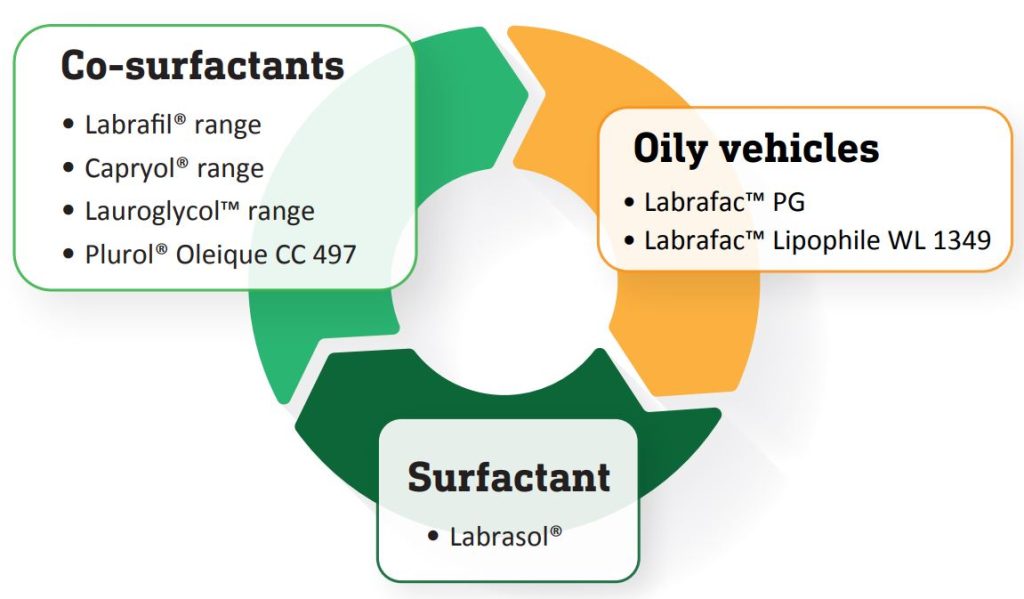
Solid dosage forms
Lipid-based nanocarriers are solid at room and body
temperature, enabling the inclusion and protection of the
drug, while facilitating its delivery to the skin. It can be used as such or serve as an intermediate product in other topical formulations, such as suspension, gel or patch.
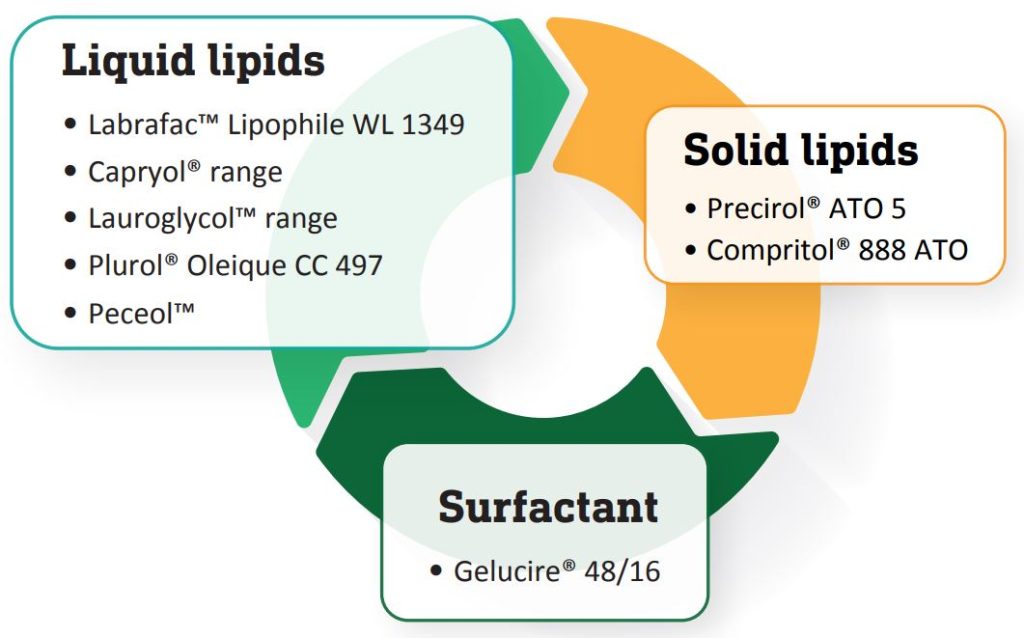
A full range of functional excipients for topical and transdermal dosage forms
Solvent – Penetration enhancers
• Capryol® 90 *
• Capryol® PGMC *
• Labrafac™ MC60 *
• Labrasol®
• Lauroglycol™ 90 *
• Lauroglycol™ FCC *
• Maisine® CC *
• Peceol™ *
• Plurol® Oleique CC 497 *
• Transcutol® P *
Emulsifiers
• Apifil®
• Gelot™ 64
• Plurol® Diisostearique *
• Sedefos™ 75
• Tefose® 1500
• Tefose® 63
Surfactants
Co-emulsifiers
• Emulcire™ 61 WL 2659
• Labrafil® M 1944 CS
• Labrafil® M 2125 CS
• Labrafil® M 2130 CS
• Plurol® Oleique CC 497 *
Co-surfactants
• Capryol® 90 *
• Capryol® PGMC *
• Lauroglycol™ 90 *
• Lauroglycol™ FCC *
• Labrafil® M 1944 CS
• Labrafil® M 2125 CS
• Labrafil® M 2130 CS
• Plurol® Oleique CC 497 *
Stabilizing agent – Thickeners
• Emulfree® Duo *
• Compritol® 888 Pellets *
• Geleol™ Mono and Diglycerides NF *
• Gelucire® 43/01 *
• Monosteol™ *
• Precifac™ 95-3 *
• Precirol® ATO 5 *
Oily vehicles – Emollients
• Gelucire® 43/01 *
• Labrafac™ PG *
• Labrafac™ Lipophile WL 1349 *
• Peceol™ *
• Suppocire® A *
Supporting your product development
Sensorial analysis: A tool to formulate patient-friendly textures
Sensorial analysis is a scientific discipline that applies the principles of experimental design and statistical analysis to measure, analyze, and interpret the characteristics of a product as they are perceived by the senses. Gattefossé has developed validated methods and established an in-house trained panel. Using this approach, we can evaluate the sensorial properties of prototype formulations to assess the influence of raw materials in the formulation, evaluate the main texture characteristics of our excipients, compare prototypes with market references, understand market preferences, construct a broad texture database, and help our customers develop their own formulations.
We have developed a kit of placebo formulations to illustrate the unlimited range of textures our functional excipients provide.
See the full technical brochure on “Skin-friendly textures” here
(click the picture to download the brochure)
Source: Gattefossé technical brochure “Skin-friendly textures”
Do you need more information or a sample of Gattefossé excipients?


